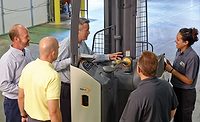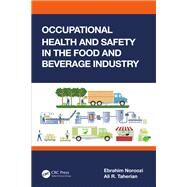National Forklift Safety Day raises awareness for operator training
Ergonomics could become major factor in forklift purchases

Toyota Material Handling U.S.A. Inc.’s new 8-Series Electric Stand-Up Rider Counterbalance forklifts include shock-dampening, isolated compartment floors; thicker floor mats; and a universal low-effort brake pedal to reduce strain on the operator’s ankles, knees, hips and lower back. (Image courtesy of Toyota Material Handling U.S.A. Inc.)

To streamline its warehouse operations, Fabiano Brothers added 20 Raymond Model 8400 end-rider pallet trucks equipped with a custom fork that is narrower and longer than the traditional fork. (Image courtesy of The Raymond Corp. and Fabiano Brothers Inc.)

Yale’s new MPB045-VG heavy-duty walkie pallet truck comes equipped with Yale’s Smart Slow Down technology to help reduce rollover accidents on turns. (Image courtesy of Yale Materials Handling Corp.)



When it comes to beverage operations, worker safety is one of the most important factors for companies to consider. From Oct. 1, 2013, to July 29, 2014, 30 workers were killed in forklift-related accidents, according to the Occupational Safety and Health Administration’s (OSHA) “FY14 Fatalities and Catastrophes To Date” report. Causes of death included falling from a forklift, a forklift turnover or crash, being struck by a forklift, and being hit by products falling from a forklift, among other causes, according to data from the Washington, D.C.-based branch of the U.S. Department of Labor. Beyond that, OSHA estimates that forklifts cause approximately 85 fatal accidents and 34,900 accidents that result in serious injury each year. Statistics like these have pushed the Industrial Truck Association (ITA), also based in Washington, D.C., to establish a National Forklift Safety Day to raise awareness for forklift safety.
The association hosted the first National Forklift Safety Day on June 10 during National Safety Month. This year’s event brought together ITA members and members of Congress to discuss forklift safety. In particular, this year’s event focused on highlighting the need for operator training.
National Forklift Safety Day garnered positive feedback and created an open channel for forklift and workplace safety conversations between representatives and manufacturers, according to ITA member UniCarriers Americas Corp., a Marengo, Ill.-based subsidiary of UniCarriers Corp. “Forklift Safety Day will continue to be an opportunity for the industry to educate customers, policymakers and the administration on forklift operating safety practices,” the company said in a statement.
The ITA plans to host National Forklift Safety Day annually on the second Tuesday of June, according to ITA President Brian Feehan.
Of course, in order to reduce the number of forklift accidents, forklift manufacturers and their customers have to practice forklift safety throughout the whole year.
“Safety is always a critical factor in the design and manufacturing process of a lift truck, says Shelley Bell, warehouse industry manager at Yale Materials Handling Corp., Greenville, N.C. “Once the equipment is on site, proper operator training is the foundation of a safe and productive operation.”
To help employers meet OSHA requirements for training their forklift operators, Yale offers its Yale Handle with Care program, which provides information for operator training and application considerations to ensure that Yale lift trucks are used properly and to help minimize risk to operators and others around the lift trucks, she says.
In addition, Yale’s new MPB045-VG heavy-duty walkie pallet truck, which the company released in March, comes equipped with Yale’s Smart Slow Down technology to help reduce rollover accidents on turns. When the operator turns the truck during cornering, this feature automatically reduces the truck’s speed, enabling the operator to maneuver through the warehouse with increased confidence, the company says.
A comfortable ride
In addition to operator safety, many forklifts are designed to provide operator comfort and ergonomics. For example, Linde Material Handling North America Corp. partners with Porsche Design Studio, Zell am See, Austria, to incorporate automotive principles into forklifts. “Studies done in anthropometrics lead the approach to apply these principles not just to world-class automobiles but [to] the machines [that] drivers sit on for days on end,” says Bob Hasenstab, product and innovative product evolution process (IPEP) manager at the Summerville, S.C.-based North American headquarters of Linde Material Handling GmbH. Together, the companies focus on ergonomic areas such as touch surfaces, seats, vibration reduction, fatigue reduction, placement of control handles and pedals, maximizing visibility areas, noise reduction, driver and pedestrian interaction, and operator positioning, among others, he says.
Toyota Material Handling U.S.A. Inc. also focused on ergonomics when designing its new 8-Series Electric Stand-Up Rider Counterbalance forklifts, which the company launched in April, says Cesar Jimenez, national product planning and training manager at the Columbus, Ind.-based subsidiary of Toyota Industries Corp. “The new model features a shock-dampening, isolated compartment floor and thicker floor mat with a universal low-effort brake pedal to reduce strain on the operator’s ankles, knees, hips and lower back,” he explains. “The new Stand-Up Rider also features a redesigned, contoured, cushioned … backrest and armrest with a new, larger elbow pad for operator comfort.”
Jimenez adds that ergonomics could become a major factor in selecting a forklift. “Ergonomics will continue to be emphasized as the operator’s comfort plays a large role in productivity,” he says. “Concern for the well-being of employees and the company’s bottom line will result in lift trucks being considered based on safety features and low operating costs.”
The right tool for the job
When choosing a forklift that can help lower operating costs, warehouse managers need to choose a forklift designed for the job at hand, says Chuck Harry, business development specialist at Abel Womack Inc., a Lawrence, Mass.-based authorized sales and service center for Raymond lift trucks. “Electric lift trucks are designed with specific tasks in mind, so there truly is a right truck for every application,” he says. The right forklift can optimize productivity, efficiency and operating costs, he adds.
When Bay City, Mich.-based Fabiano Brothers Inc. consolidated its three beer facilities into one, the beverage distributor worked with Andersen Material Handling, a Wixom, Mich.-based authorized sales and service center for Raymond lift trucks, to choose forklifts dedicated to specific tasks to make their operations more efficient, according to the case study “Full Service Solutions Contribute to Optimal Warehouse Efficiency” by The Raymond Corp., Greene, N.Y. With Andersen Material Handling’s guidance, Fabiano Brothers chose sit-down counterbalanced lift trucks with cascade single/double pallet handlers to increase their truck unloading capabilities at the loading dock; end-rider pallet trucks equipped with a custom fork that is narrower and longer than the traditional fork to boost carrying capacity; and stand-up counterbalanced lift trucks, which offer a sleek, narrow design and a clear view mast that allows operators to maneuver through narrow aisles and lift full loads to greater heights, for pick-path replenishment and loading trucks.
As a result of this forklift selection, Fabiano Brothers reports a much higher level of productivity per man hour in both the picking and delivery processes, according to the case study.
In addition, other warehouse operations can call for certain types of forklifts. Abel Womack’s Harry offers these examples of forklift duties:
- Stand-up counterbalanced trucks, which are designed to be ergonomic and save space, are suited for putting away product, replenishing pick areas, and some order-picking and pallet-loading tasks.
- Order pickers can be used with slower movers in reduced spaces to free up needed space for new SKUs. They also have been used in secured rooms for expensive wines and spirits.
- Reach trucks specialize in narrow aisles because of the trucks’ smaller width.
- Walkie and rider end-control pallet trucks are more productive, ergonomic alternatives to the traditional option of picking-off sit-down trucks, allowing for increased productivity and improved ergonomics.
- Small, compact electric pallet trucks are being used on delivery trucks in place of hand pallet trucks.
Special attachments also can help streamline operations, Linde Material Handling’s Hasenstab notes. For example, a single/double attachment can combine single-pallet handling and double-pallet handling on one truck, he says.
In addition to streamlining operations, using the proper forklifts and tools can further support the safety of forklift operators, Toyota’s Jimenez points out. “Since lift trucks are used in an endless array of applications and environments, employers must ensure that lift trucks used in their operations are equipped properly,” he says. “Employers proactively working in collaboration with lift truck professionals at the local dealer will ensure the equipment and features selected are appropriate for the application, thereby enabling that certified lift truck operator to maximize safety within the workplace.”
Three ways to properly maintain propane-powered forklifts
Nearly 60,000 propane-powered forklifts were sold in the United States last year, making up a significant share of the forklift market, according to The Propane Education & Research Council (PERC), Washington, D.C. Propane is a clean, American-made fuel with very low emissions, making propane forklifts safe for indoor and outdoor operations, it says.
As with all forklifts, however, there are certain steps forklift fleets can take in order to ensure continued safe operation:
Step 1: Practice preventative maintenance.
Preventative maintenance is designed to preserve equipment reliability by replacing worn components before they fail. The PERC recommends that propane-powered forklifts receive filter and lube service at least every 1,000 hours or every four months, whichever comes first. Jeremy Wishart, deputy director of business development for the PERC, adds that lift truck fleet managers should consult with their equipment manufacturer for specific service intervals, as recommendations can vary.
“Preventative maintenance is less expensive than a service call and can be scheduled around off-peak hours of business operation,” Wishart said in a statement. “Servicing forklifts before any issues arise ensures minor problems will be caught before they become more extensive and costly.”
Step 2: Prepare the repair facility.
Safety is an important consideration for any repair facility, and facilities servicing alternative fuel equipment are no exception. Forklift fleet managers should review the National Fire Protection Association Code 58 for information on fuel storage and garaging procedures with propane-powered equipment, the PERC says.
“Propane has similar requirements when compared with gasoline, so facilities that are compliant with conventional fuel codes can often accommodate propane-powered equipment without modifications for ventilation, gas detection or electrical requirements,” Wishart said. “That’s not the case with all alternative fuels, so it’s important to know the requirements for equipment up front.”
When servicing and repairing propane-powered machinery, the work should be performed in the lowest point of the facility, and the tank supply should be shut off when possible, the PERC says.
Step 3: Handle the fuel safely.
Propane is a safe and versatile fuel when handled properly. The PERC reminds forklift fleet managers to visually inspect cylinders and mounting brackets for any damage before refilling a propane tank. Also, make sure the tank is mounted properly and that the mounting pin is engaged on a regular basis. If there is a problem, Wishart recommends leaving repairs to a professional.
“Don’t try to modify or repair valves, regulators or other cylinder parts,” Wishart said. “Always call a propane provider or qualified service technician for assistance if there’s ever any uncertainty.”
A few small steps can ensure the safe and easy operation of propane-powered forklifts and their components. Spending a few minutes up front diagnosing small issues often can prevent unnecessary costs and larger problems further down the road, the PERC says.
Looking for a reprint of this article?
From high-res PDFs to custom plaques, order your copy today!












